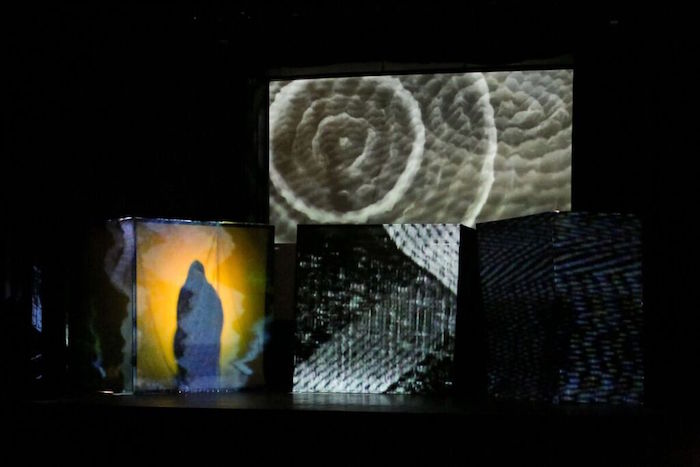For the first of five concerts in the Cluster New Music and Integrated Arts Festival, the audience at Winnipeg’s West End Cultural Centre on March 12 was involved in a multi-dimensional aesthetic environment which ultimately, for me, privileged the human breath. I say involved because it doesn’t make much sense to use the language of listening, or watching, or attending a concert when you approach Cluster.
CBC reporter Teghan Beaudette earlier in the day had offered the opinion that Cluster isn’t so much a music festival as a sound festival, and she’s close. But even more than emphasizing sound, the March 12 event was distinguished by its imaginative amalgamation of light, tone, colour, word, shape, and space, so it’s difficult in description to highlight any particular element, genre, or performer. But I did feel, throughout, an appreciation of many kinds of human breath – ragged, painful, calm, joyous.
The conception for the seamless evening of sight and sound apparently originated with Eliot Britton, but once we experienced “A Prairie Drone Companion” – a droll title that, however, didn’t really fit the sombre and spare beauty of the evening – it was democratically ambiguous who was responsible for what. I’ll go out on a limb and give high marks to Winnipeg projection artist jaymez for gorgeous visuals, involving multiple projections on a conventional screen as well as on three specially constructed large translucent boxes, within which we could get evocative glimpses of performers.
Often what was happening within those shadowy boxes concerned amplified breathing, occasionally harsh but mostly mesmerizing. I also liked Reiko Yamada’s broken accordion work and Sara Jo Kirsch’s ethereal soprano, although in each case the sound was perhaps too subtle. (I surprised myself by longing for more of the huge, nearly oppressive space that the doom side of drone can entail.)
What didn’t work as well was the meshing with storyteller Jamie Oliviero’s more conventional, earnest contribution. The overall visual and sonic atmosphere was suggestive and otherworldly; while Oliviero’s humane storyline (loosely adapted from Tolstoy’s 1885 fable “Three Questions”) shouldn’t have been jarring – it was too gentle to be called that – in juxtaposition with the other elements of the performance, it did, finally, seem jarring.
It’s tricky to describe an event like a Cluster Festival concert. At a basic level, one can cite Laurie Anderson or John Adams or Brian Eno’s ambient music, and if your listener seems comfortable enough, you can move on from there. For this sort of cultural happening to succeed, it has to successfully stimulate the side of our perception that likes abstraction, meditation, and unknowing – and then engage simultaneously with our sometimes overbearing human need to make things precise and tangible. At several moments on March 12 at the WECC this strange convergence worked; then I was sorrowful that events like this are one-off and can never truly be reproduced.
I am not sorry, however, that it is so hard to explain such events. Wrestling with concepts and ideas and then trying to throw a net of words around something guaranteed to escape is part of the fun.
I have sidestepped so far what may have been the thing I felt most affectionate about at Cluster 1: Matthew Schoen’s sound art/videos vehicles and Home Appliance, which supplied a playfulness missing from the rest of the work. Schoen’s work put me in touch with my apparent inner need to mash up the 1957 Sputnik, the supermarionation of mid-sixties Thunderbirds, and certain episodes of Doctor Who. If none of that makes sense, here’s another way in: if you find yourself drawn to contemplation of your electric coffee grinder or you hum strange melodies while disemboweling old blenders, you will have been in the same place I was.
Cluster continues with four concerts March 17-20, at various Winnipeg locations. More information at clusterfestival.com.
***
Sue Sorensen teaches English at Canadian Mennonite University and asks you this musical question: How do you know when an accordion is broken?
